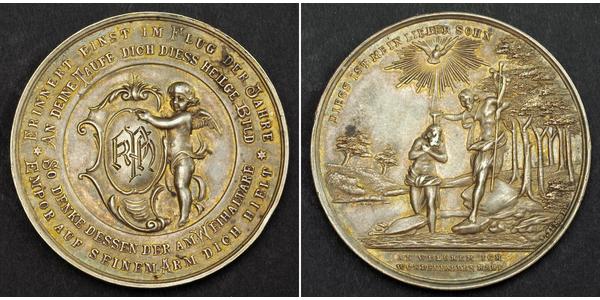(sold for $67.0)
1900, Austria. Silver "Baptizing Presentation" Medal by Leo Zimpel. 24.21gm!
Mint Place: Vienna Mint Period: ca. 1900 Reference: GPH 1127. Denomination: Baptizing Medal Medallist: Leo Zimpel (Austrian Engraver, 1860-1923) Condition: Engraved monogram (kPh) in obverse, light edge-bumps and minor deposits, otherwise a nicely toned AU+ Weight: 24.21gm Diameter: 39mm Material: Silver
Obverse: Winged cupid within central medallin, holding oval table (which was engraved with a monogram - KPH) within foliage. Double band of legends around. Legend: ERINNERT EINST IM FLUG DER JAHRE / AN DEINE TAUFE DICH DIESS HEILIGE BILD * SO DENKE DESSEN DER AM WEIHALTARE / EMPOR AUF SEINEM ARM DICH HIELT * Translated: "REMEMBERING IN THE FLIGHT OF THE YEARS / AT YOUR BAPTISM YOU DIESS HOLY PICTURE * SO THINK OF WHICH HELD YOU AT THE CONSECRATION ALTAR / EMPOR IN HIS ARM *"
Reverse: Baptizing scene of Jesus by Saint John at the River Jordan near Bethabara. Illuminated dove (Holy Spirit) above. German inscription above and in exergue. Medallist´s signature (L.ZIMPEL) at 4 o'clock near edge. Legend: DIESES IST MEIN LIEBER SOHN ("THIS IS MY DEAR SON") Exergue: AN WELCHEM ICH WOHLGEFALLEN HABE ("WHICH I WOULD HAVE WELL")
Loos, Daniel Friedrich: Daniel Friedrich Loos (1735-1819) was born in Altenburg, spent time in Prussia, and was appointed chief engraver and Medallist to the Court at Berlin in 1768. Forrer, quoting Bolzenthal, states that Loos was a diligent artist who, in a time of bad taste, applied himself to the study of portraiture and ancient types. Loos also made various discoveries in the art and technique of striking coins. He had two sons, Friedrich Wilhelm and Gottfried Bernhard, who became medallists in their own right.
Baptism (from the Greek noun βάπτισμα baptisma; see below) is a Christian sacrament of admission and adoption, almost invariably with the use of water, into the Christian Church generally. The canonical Gospels report that Jesus was baptized —a historical event to which a high degree of certainty can be assigned. Baptism has been called a holy sacrament and an ordinance of Jesus Christ. In some denominations, baptism is also called christening, but for others the word "christening" is reserved for the baptism of infants. Baptism has also given its name to the Baptist churches and denominations.
The usual form of baptism among the earliest Christians was for the candidate to be immersed, either totally (submerged completely under the water) or partially (standing or kneeling in water while water was poured on him or her). While John the Baptist's use of a deep river for his baptism suggests immersion, "The fact that he chose a permanent and deep river suggests that more than a token quantity of water was needed, and both the preposition 'in' (the Jordan) and the basic meaning of the verb 'baptize' probably indicate immersion. In v. 16, Matthew will speak of Jesus 'coming up out of the water'. The traditional depiction in Christian art of John the Baptist pouring water over Jesus' head may therefore be based on later Christian practice." Pictorial and archaeological evidence of Christian baptism from the 3rd century onward indicates that a normal form was to have the candidate stand in water while water was poured over the upper body. Other common forms of baptism now in use include pouring water three times on the forehead, a method called affusion.
Martyrdom was identified early in Church history as "baptism by blood", enabling martyrs who had not been baptized by water to be saved. Later, the Catholic Church identified a baptism of desire, by which those preparing for baptism who die before actually receiving the sacrament are considered saved. As evidenced also in the common Christian practice of infant baptism, baptism was universally seen by Christians as in some sense necessary for salvation, until Huldrych Zwingli in the 16th century denied its necessity.
Quakers and The Salvation Army practice Baptism with the Holy Spirit instead of baptism with water. Among denominations that practice baptism by water, differences can be found in the manner and mode of baptizing and in the understanding of the significance of the rite. Most Christians baptize "in the name of the Father, and of the Son, and of the Holy Spirit" (following the Great Commission), but some baptize in Jesus' name only. Much more than half of all Christians baptize infants;[b] many others hold that only believer's baptism is true baptism. Some insist on submersion or at least partial immersion of the person who is baptized, others consider that any form of washing by water, as long as the water flows on the head, is sufficient. The term "baptism" has also been used to refer to any ceremony, trial, or experience by which a person is initiated, purified, or given a name.
Only 1$ shipping for each additional item purchased!

|
Posted by:
anonymous 2019-05-16 |
2 Corona Austria-Hungary (1867-1918) Silver
group has 12 coins / 9 prices
⇑







-300-150-piIR018gFOsAAAGLlwDsXZhV.jpg)






